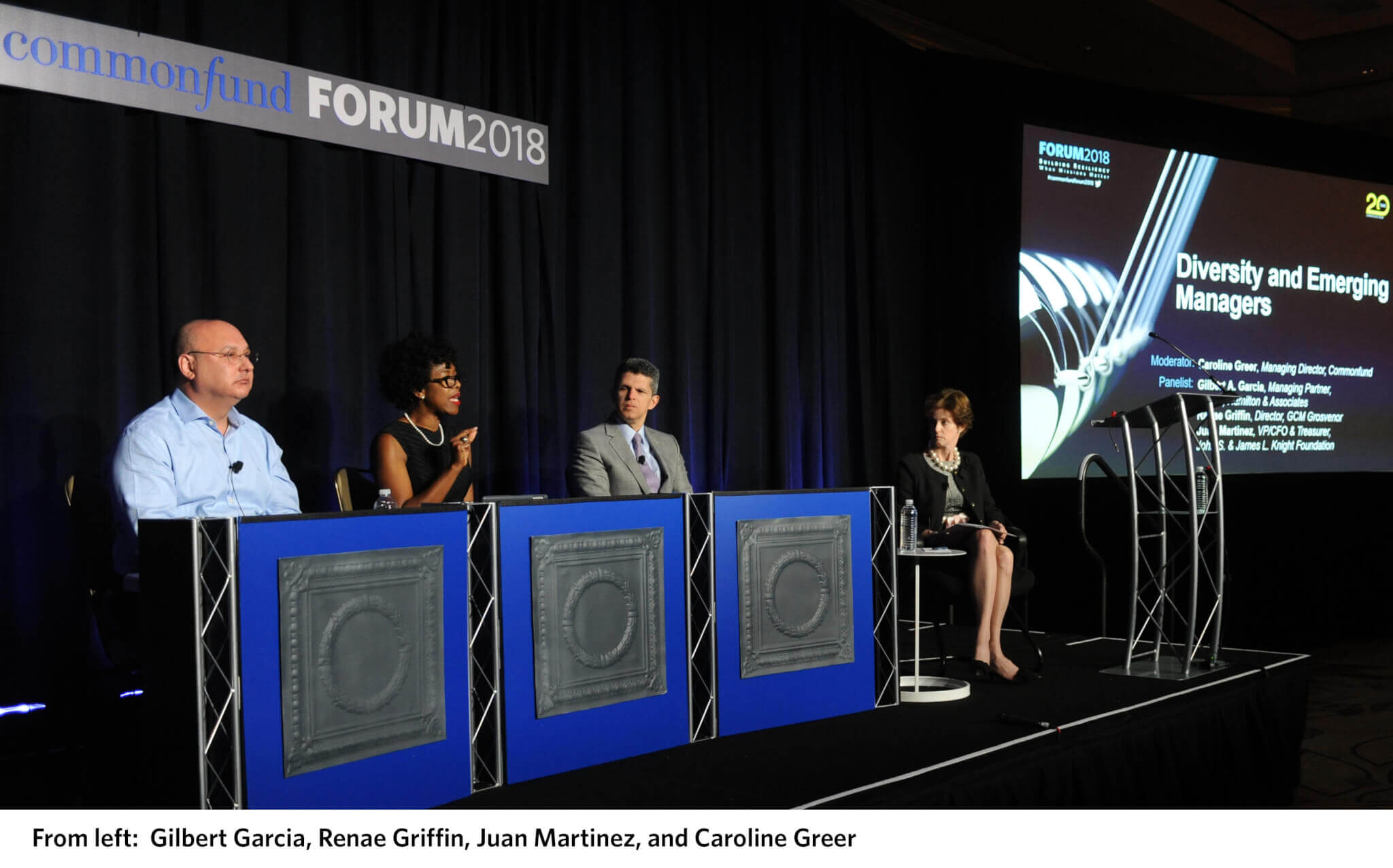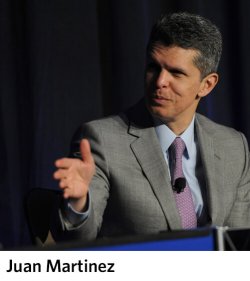The benefits of diversity are widely recognized in the work place and among educational institutions and other nonprofits. Yet, the concept of investment management firms that are minority owned and operated lags, partly because of the challenge of attracting investors’ capital.
In this Commonfund Forum 2018 session, two minority managers representing very different strategies and an executive of a leading foundation discuss the case for investing with diverse managers.
This panel was moderated by Commonfund Managing Director Caroline Greer. The panelists were: Renae Griffin, a Director at global alternative asset manager GCM Grosvenor Capital Management; Gilbert Garcia, Managing Partner of fixed income manager Garcia, Hamilton & Associates; and Juan Martinez, Vice President and Chief Financial Officer of the John S. and James L. Knight Foundation. Comments have been edited for clarity and length.
Caroline Greer: Renae, we hear about minority managers, diverse managers and women-owned businesses. Help us sort out all of these definitions and the nuances with respect to each.
Renae Griffin: The definition depends on which institution you’re speaking to—often times, what state you are talking about—but I will say this: emerging managers are synonymous in some cases with diverse managers. Diverse managers tend to be about 90 percent of the subset of emerging managers. There are, however, diverse managers who don't fit into the emerging manager category at all. Some are quite large and have surpassed certain levels of AUM, but are still considered diverse. That said, there are some standard criteria. In private markets—typically private equity, real estate and hedge funds—the level is $2 billion or less under management.
We look at target fund size that these managers are pursuing, and that’s generally under $1 billion. We also look at the number of institutional funds that they have raised—typically one to two by some definitions, but up to three by other definitions. In terms of the percentage of ownership, the threshold is typically 33 percent, whether African American, Latino and Hispanic, Native American, disabled and disabled veterans, women or LGBT.
I mentioned how definitions vary by state. It’s very uneven. In Illinois, for example, the definition of an emerging manager measured by AUM is capped at $10 billion. In California, where I’m from, state government agencies cannot focus on emerging or minority-owned managers because of Proposition 209, which forbids them from considering race, sex or ethnicity in public contracting, although they do incorporate them into their definitions and strategy.
Gilbert Garcia: I started full-time in the business in 1985 when the effort was clearly about minority firms, about under-represented firms. It wasn't until the ‘90s that it began to morph into “emerging,” as there was pushback in California, Texas and some other areas. The frustrating thing about “emerging” for a lot of us in this space is its unintended consequence. That is, you're getting firms that are non-minorities or non-women spinning out of major firms and they are competing for emerging manager allocations. Another challenge is that if you cap the definition of an emerging manager at a certain level of AUM, the very best emerging managers may then be locked out of consideration because they will reach that level the fastest. A cap level kind of defeats the purpose it’s intended for, which is to provide new, emerging managers with opportunity as well as to source alpha anywhere you can.


— Juan Martinez
Greer: Juan, how did the concept of minority managers evolve at the Knight Foundation?
 Juan Martinez: For us, it goes back about seven years when our CEO raised the question of diverse managers. The Knight Foundation believes in diversity—it’s one of the pillars of our strategy and mission. While we had about $2.1 billion in assets seven years ago, we had one African American private equity manager managing $7 million for us. Today, about $700 million of our portfolio is managed by minority and women managers. The manager set is pretty well allocated across all our asset classes. These managers perform in line with their peers, if not better, and they are doing what we need them to do within the portfolio.
Juan Martinez: For us, it goes back about seven years when our CEO raised the question of diverse managers. The Knight Foundation believes in diversity—it’s one of the pillars of our strategy and mission. While we had about $2.1 billion in assets seven years ago, we had one African American private equity manager managing $7 million for us. Today, about $700 million of our portfolio is managed by minority and women managers. The manager set is pretty well allocated across all our asset classes. These managers perform in line with their peers, if not better, and they are doing what we need them to do within the portfolio.
Just to comment on what Gilbert said, in this industry we underestimate the power of incumbency. We do what is comfortable for us, we go to the places where we’ve always gone. We recruit at the universities where we are alums. We look at managers who spin out of firms that we already invest in. We’re in our comfort zone. At the Knight Foundation, we simply decided that we were going to add diversity to our portfolio, and we were going to be purposeful about doing so. We did not say we are going to have “X dollars” focused on emerging managers. We said we are going to add diversity to our portfolio, period. We are not going to have a separate benchmark for those managers. They need to be of institutional quality and will earn market returns for us or they will not be in our portfolio.
Greer: Renae, perhaps you could talk about some of the myths about investing in diverse managers.
 Griffin: We’ve made some progress in demystifying the space, but there’s still room for improvement. If you’re looking at some of the newly-launched diverse firms, you may compare them to spinout groups that are non-diverse and that raise money quickly. It may take time for diverse managers to move up on the fund-raising curve, but, I’ll tell you, that is no reflection on the quality of the firm.
Griffin: We’ve made some progress in demystifying the space, but there’s still room for improvement. If you’re looking at some of the newly-launched diverse firms, you may compare them to spinout groups that are non-diverse and that raise money quickly. It may take time for diverse managers to move up on the fund-raising curve, but, I’ll tell you, that is no reflection on the quality of the firm.
Often, diverse managers who spin out of large firms have not have focused on LP relationships. They may have been focused on portfolio management, working with their teams, making sure they’re performing and making money for their clients. When they spin out and hang their own shingles, they have to acquire marketing skills and figure out how to navigate the LP terrain. In addition, diverse managers are often plagued with questions like, “Are you qualified?” Of course, they’re qualified. They’ve been running billion-dollar portfolios for much of their career. Sometimes, they are viewed as riskier, which, based on our experience at Grosvenor, is not true because we have found that smaller managers have the same inherent risk as other managers. Another myth concerning diverse managers is that they cannot handle large allocations. Simply not the case.

— Renae Griffin
 Garcia: We have seen numerous barriers to entry over the last 20 years. It started with questions about whether emerging managers had the right education. Then a lot of us started going to good schools and getting advanced degrees. Then the challenge was the CFA, and after many of us obtained that designation the question shifted to the lack of a track record or not having enough insurance. Renae mentioned risk as another hurdle. Well, risk is there whether you’re small or large. No one was too concerned about risk when they spoke about Merrill Lynch, Countrywide, Lehman Brothers or Bear Stearns.
Garcia: We have seen numerous barriers to entry over the last 20 years. It started with questions about whether emerging managers had the right education. Then a lot of us started going to good schools and getting advanced degrees. Then the challenge was the CFA, and after many of us obtained that designation the question shifted to the lack of a track record or not having enough insurance. Renae mentioned risk as another hurdle. Well, risk is there whether you’re small or large. No one was too concerned about risk when they spoke about Merrill Lynch, Countrywide, Lehman Brothers or Bear Stearns.
I can cite anecdotal evidence that I have observed about diverse firms being held to a different standard. They have one bad quarter or one person leaves and they’re immediately on watch. But “branded” managers may get entangled with lawsuits or SEC problems or suffer turnover, but there’s no action.
 Greer: There is, unfortunately, some evidence to show that women really suffer in raising capital. There was a very interesting blind study done in which prospective investors were given portfolio A and portfolio B. They were identical, and they were actually just S&P returns. The prospective investors were asked to select based on the name of the manager, the names being that of a woman and that of a man. Roughly 80 percent of the investors chose the man’s name despite the identical performance.
Greer: There is, unfortunately, some evidence to show that women really suffer in raising capital. There was a very interesting blind study done in which prospective investors were given portfolio A and portfolio B. They were identical, and they were actually just S&P returns. The prospective investors were asked to select based on the name of the manager, the names being that of a woman and that of a man. Roughly 80 percent of the investors chose the man’s name despite the identical performance.
Martinez: We’ve invested in very large firms that are well established and we’ve invested in smaller, startup firms. What has been helpful for us is understanding that the emerging manager early in its life cycle may not have the sophistication to deal effectively with LPs or sufficient experience to structure funds or terms and conditions. So, being flexible as you go into the relationship, being willing to spend a little more time or being willing to share your experiences is very valuable to the emerging firm . . . and to you, as the investor: You may be able to identify alpha generators early or lock in advantageous terms for the future.

— Gilbert Garcia
Martinez: The Knight Foundation is a partner in the Diverse Asset Managers Initiative, an effort to increase the absolute number of, and assets under management by, diverse-owned asset management firms for institutional investors. The effort seeks to address the under-representation of emerging manages hired by institutional investors, despite evidence that there is a critical mass of high-performing diverse asset managers. It’s amazing to me that this is one of the only areas in our society where we’re having conversations that go something like, “If I hire a woman to do this job, I expect to get lower returns” or “I would love to hire an African American for this job, except that I expect them to perform 20 percent worse. And I’m going to benchmark them against that.” That’s incredible. I mean, think about the context of that conversation.
If you were to look at the Knight Foundation’s board, you’d find an incredible amount of diversity, including women and minorities. Ours is a very diverse organization, including senior staff members. We look at it as no big deal. We get asked, “How did you get buy-in from the board?” Well, the board itself is diverse.
Griffin: That is a good thing, and we are seeing more of it. More diverse board members are coming into organizations and beginning to advocate for inclusion, and they’re being armed with tools and strategies to do so. We’ve seen the rationale evolve from just including diverse managers for the sake of inclusion to the legitimate desire for diversity in your portfolio. You want to make sure that you’re mitigating risk against large manager concentration. And, today, you want to make sure you’re getting in early with promising emerging managers. You want to make sure you’re seeing the best talent that’s out there. In many cases, it has been proven—there are a lot of reports indicating that diverse managers outperform many of their peers, many non diverse managers as well as large firms. That’s really the case for institutional investors to be investing with diverse managers.


